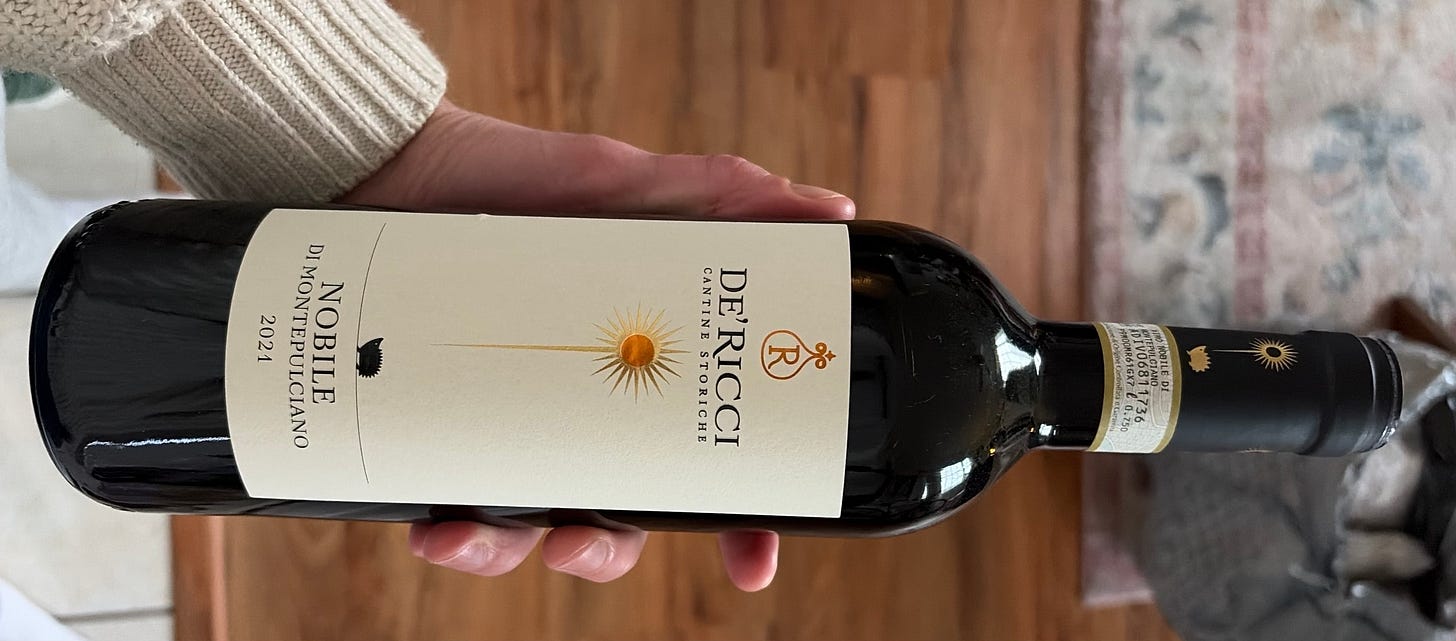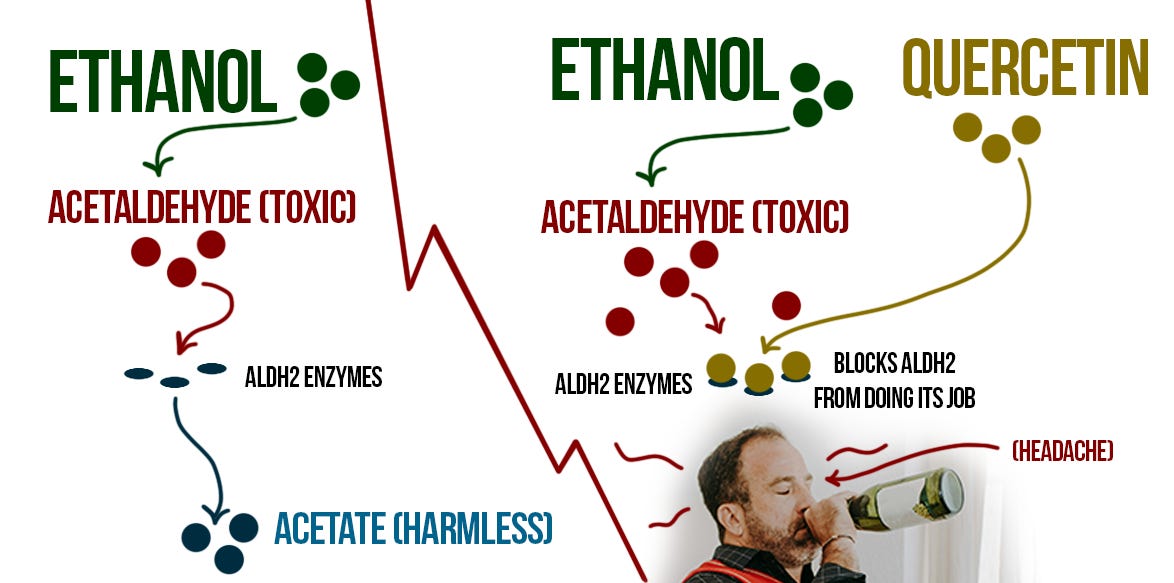Tannic Panic! Issue #130: Why Red Wine Gives You Headaches (And Why It Also Doesn't)
Taking a crack at the mystery and myth surrounding headaches from red wine
You’ve probably heard people complain that red wine gives them headaches – in fact, you may be one of those people (UNLIKE ME!). But the common theories for why, even those with a scientific basis, appear flimsier and flimsier as we dig deeper into the underpinning mechanisms and other implications of their impact on the proverbial noggin. In many cases the reality of it suggests that same compounds are contained foods we consume on a daily basis and thus everyday eating would be a more likely trigger. In other words, in the absence of symptoms when eating “our meals,” it becomes increasingly dubious to blame those compounds for headaches in wine.
As such, today we’re going to take a little headfirst dive into the most commonly spouted theories, highlighting where they get it right, where they get it wrong, and what our take on the whole debacle is.
Because this post was inspired by the following sequence of events…
Friend goes to Italy → drinks red wine (as one does) → magically gets no headaches (usually he gets them from reds) → attributes this to “lower sulfites” in Italian wine (the explanation the winemaker offered him)
… sulfites is where “we” will begin.
SULFITES AKA “SO2”
One of the wholesomest misconceptions in the wine world is that sulfites are giving you headaches. Wrong! And doubly so when arguing for why red wine specifically gives your needle nosed noggin a nasty one.
Not only do sulfites appear in higher concentrations in most white wines than reds (because whites typically need more protection from oxidation), everyday foods like dried fruit, french fries, pickles, and cured meats often contain far more sulfites per serving than any glass of [INSERT YOUR FAVORITE WINE HERE] ever will.
Nevertheless, the premise that sulfites are responsible for wine headaches has not only taken root as a popular little idea among wine drinkers (steeped in the industry or otherwise), it has even prompted the creation of a whole spread of products that claim to magically remove sulfites from wines and has spurred sometimes misguided support for a movement to eliminate the use of sulfur in the winemaking process altogether. And while sulfites are technically toxic to humans in substantial quantities, this isn’t unique to products we consume (perhaps you’ve heard of salt), and for the most part, they make wine safer and more enjoyable to drink.
To give a sense of relative quantities of SO2 in wine versus foods, take a look at this neat little bar chart courtesy of Wine Folly:
Some “individuals” may be more sensitive to sulfites (“poor them”), but in the rare instance someone does have a true sulfite sensitivity, the reaction is overwhelmingly respiratory, not “headache-atory,” so you’ll be wheezing your little asthmatic heart out well before you keel over to massage your sensitive little “cabeza.”
As for our goodly friend who went to Italy who we’ll call “Brandon” because that’s his real name — while it is true that Italy caps the total allowable sulfites in red wine at 150 mg/L (it’s 200 for whites and up to 400 for sweet wines) which is significantly less than the U.S.’s 350 mg/L cap, the average sulfite level in a dry red is still about the same as a dry red in Italy (~50mg/L). It’s those highly manipulated mass market reds that typically have the highest sulfite levels, and again, it’s still not particularly high relative to widely consumed and barely scrutinized foods.
In other words, given its greater prevalence in other dietary staples like your morning fistful of raisinated goji berries, the bottom line here is simple: if sulfites were the issue, “Brandon” probably have known it years before he poured himself a glass of “the good stuff” (OR THE BAD STUFF).
HISTAMINES
The next “popular scapegoat” for us to point our stubby little fingers at – histamines – has some merits. If you already suffer from severe histamine intolerance or a deficiency in the enzymes that help break histamine down, you can experience symptoms when consuming high-histamine foods and/or beverages. But this is a tiny percentage of the population, and generally speaking for those people, wine is far from the worst offender.
According to “research,” aged cheeses, sauerkraut, eggplant, spinach, fish, sausage, and salami all contain vastly higher histamine levels than red wine ever will (JACI study). Another study found no correlation between wine quality and histamine concentration, meaning you can’t buy your way out of histamine exposure by avoiding mass market plonk (PubMed).
Bottom line: if histamines are the culprit, you’re probably already sneezing your merry little way through life and wine is the least of your worries.
TANNINS
Then there’s this shiny little thing called “tannins” (REMEMBER THOSE?) – a polyphenolic compound that exists in far greater concentrations in red wine than white. Tannins don’t get thrown around too much as an excuse for advil, but they merit mention because they can sometimes cause headaches in specific situations. They don’t tend to affect the cranial well-being of the general population, but there is a mechanism by which they can – serotonin release – and the people who get got by this little bugger are among the small population whomst find themselves unusually sensitive to this pathway.
If tannins affect you, then black tea, dark chocolate, walnuts, or even the elusive juice of the humble “pomegranate seed” would all present a similar issue for you.
For 99% of “drinkers,” tannins aren’t the problem – they’re the solution (THE GOOD KIND!).
WINE ADDITIVES
It’s also worth addressing wine additives, because this is where things get both nuanced and overblown. The U.S. does indeed permit a noteworthy number of winemaking additives, but that does not mean every American wine is a ticking time bomb of megapurple, vanillin, and gizzard juice. Many U.S. producers, especially small, quality-focused ones, more or less limit additions to the classic trio: grapes, yeast, sulfur.
Many other countries also allow a range of additives, though they may be disclosed differently or culturally normalized. Basically, there’s no blanket statement about wine from one country or another that can reliably indicate what is contained in the bottle, it comes down to the winemaker’s decisions and in many cases, far more localized regulations (e.g., AVA wines, DOC wines, etc).
To bring us back to the example of wine in good old Italy – yes, American wine at the lowest price points is often more manipulated than Italian wine of the same cost. It also often harbors a bit more residual sugar, which can increase the likelihood of headaches because it can contribute to dehydration. As such, this could well be the culprit if “Brandon” has been primarily buying cheap American wine when at home. A simple solution to test this theory would be to try a bottle of cheap Italian wine and see if the headaches go bye bye.
And now we must examine our final candidate for the presidency: Quercetin.
WHAT IS QUERCETIN?
Quercetin is a colorless flavonol (a type of polyphenol) found at variable levels in black grape skins (the kind used to make “red” wine) that accumulates in response to sun exposure. As a result, the concentration of quercetin varies dramatically across grape varieties depending upon sunlight, viticultural practices, region, vintage and the intrinsic characteristics of the grape.
Nebbiolo, Cabernet Franc, and Pinot Noir contain notably high levels, while Sagrantino and Tannat, despite their notorious tannin content, show among the lowest quercetin concentrations, highlighting a fundamental biochemical distinction between the two polyphenolic compounds, tannins and quercetin. NEATO!!!
So what in gods green gizzard does quercetin have to do with the humble “headache”?
In “the simplest terms,” quercetin can make it so we get a headache more easily from consuming alcohol.
That’s because it can slow the body’s breakdown of acetaldehyde, the toxic compound formed when we metabolize alcohol. The more quercetin we consume, the longer “the bad stuff” lingers, and ipso facto, the worser the headache may be.
The alleged headache mechanism involves a “metabolic competition” between alcohol and quercetin. When you drink alcohol, the liver converts ethanol to acetaldehyde (a goodly “toxin”), which is then metabolized by the enzyme aldehyde dehydrogenase 2 (ALDH2) into the unassuming and harmless acetate molecule (the acid component of humble “vinegar”). But quercetin — specifically its metabolite, the infamous “quercetin-3-glucuronide” (Q3G) — inhibits ALDH2 enzyme activity, reducing its ability to efficiently break down acetaldehyde.
The result of this jovial little “battle” is that acetaldehyde accumulates to higher levels and gets cleared more slowly when alcohol is consumed in the presence of its little “friend” quercetin, which potentially amplifies “symptoms” such as flushing, nausea, and headaches (THE BAD KIND) in “susceptible individuals.”
Critically, this effect requires both components to be present: quercetin alone (present in onions and other plant “foods”) causes no headache on its own; alcohol alone does indeed produce headaches when consumed in excess; but quercetin + alcohol synergizes to increase acetaldehyde accumulation.
In theory, this also means that pairing wine with high‑quercetin foods (e.g., anything heavy on onion, capers, shallots) might have a similar (or even more pronounced) headache‑inducing effect to a “high quercetin red wine,” because the metabolic interaction happens in the bloodstream, not in the glass.
For context, a typical medium red onion (about 148 g) contains on the order of 40–60 mg of quercetin, with a reasonable mid‑range estimate around 47 mg. By contrast, a standard 5 oz (≈148 ml) glass of red wine averages only about 1.2 mg of quercetin, with a realistic range from roughly 0.07 mg in low‑quercetin reds up to about 4.7 mg in very high‑quercetin examples. Even for a grape like Nebbiolo, which sits at the high end of the spectrum (LIKE ME) and can clock in around 8 mg/L, a 5 oz pour delivers only about 1.2 mg of quercetin.
That’s about 40 times more quercetin in a single red onion than a 5 oz glass of a high‑quercetin red such as Nebbiolo.
And while this emerging hypothesis has a ton of well understood science to back it up and does offer a viable explanation for the red wine headache, the fact that foods people regularly consume with all types of alcoholic beverages contain much higher levels of quercetin than red wine weakens the argument for quercetin being the primary cause.
http://phenol-explorer.eu/contents/show/1/291/135 table from → https://pubmed.ncbi.nlm.nih.gov/10554248/
So What Options People With “Red Wine Headaches” Actually Have?
Option 1: Give up and live a miserable, red wine free life. This one is a nice one-step solution and can be implemented immediately.
Option 2: Take a look at the problem with fresh eyes. If you have experienced headaches as a result of consuming red wine on multiple occasions and you are confident that something in red wine is the cause, the goal should be to figure out why. The chemical composition of a glass of red wine can vary greatly from bottle to bottle (depending on the varieties used, the winemaking style, etc.) and especially in cases where certain wines have been identified that don’t cause the adverse reaction, you need to gather more data points to paint a fuller picture.
Generously assuming you’ve ruled out the possibility that the headache came from drinking too much alcohol, next step is to focus on things in red wines that have indeed been identified as possible culprits. We know it’s not sulfites if white wines don’t also give you headaches, so we can rule that out (and can probably rule it out either way).
For histamines, identify a couple of high histamine foods and see if you end up with a headache from simply eating those. If so, lucky you! You’ve found what may be at fault and there are anti-histamines you can take to brighten your life.
For our leading candidate, quercetin, since the reaction is directly linked to the presence of both quercetin and alcohol during the metabolic process, try drinking a known low-quercetin wine and a high-quercetin wine on separate nights. Control the other variables, like hydration, food consumption (and food type – remember, quercetin exists at higher levels than any wine in many foods, such as onions), and number of glasses consumed. Alternatively, try consuming a quercetin rich food (like red onion, preferably cooked) and drinking a glass of white wine and seeing what happens.
None of these solve the mystery for you? Experiment! Solve the mystery for the world! Try drinking small quantities of different varieties of reasonable quality and see if you can identify any trends. There are so many different compounds present in wine, there’s a good chance the real causes are yet to be identified.
Option 3: Embrace the possibility that it isn’t wine being red that is the cause. Factors like higher abv (compared with white wine), residual sugar, undisclosed additives, and your own dietary and hydration choices could well be at play here. If you spend the same budget on red wine as white wine, then it’s also worth noting that at lower price points, especially in the United States, red wines are far more likely to be manipulated and contain other additives and higher levels of residual sugar. In that case, it could be that the simple solution is finding higher quality red wines (which doesn’t necessarily mean forking up more money).
Option 4: If all else fails, embrace the headache. Own it, make it yours. Don’t let anyone or anything take it away from you.
Now we didn’t do any histamine tests (sorry, dad), but we did review a white wine, a high quercetin red, and a low quercetin red, all of which we recommend, and all of which can be used in your little experiments to come. None of them gave us headaches, but for us, they never do.
… AND NOW FOR THE REVIEWS (IN ORDER OF PRICE):
[CLICK HERE FOR A BREAKDOWN OF HOW OUR 100PT RATING SYSTEM WORKS]
2024 Chardonnay Viognier, France / $7 [WHITE WINE]
Profile: Honeydew melon, gardenia, white peach, sea shell, lemon zest
Palate: Dry, medium acid, full body, long finishI’d call this aromatically pleasant and highly drinkable. A crisp, floral and melon-driven profile. It’s not particularly rich or concentrated, and it would benefit from some more vibrance – a bit more acid, a bit more fruit on the palate. That said, for $7, this is a solid get, and no headache ensued.
Forgot to score it, but it’s solid value for the money (I).
2021 Fratelli Revello Barolo / $32 [HIGH QUERCETIN OPTION]
Profile: Red cherry, cranberry, dried strawberry, roses, violets, tar, menthol, licorice, iron, black tea, wet stone
Palate: Dry, high tannin, high acid, medium+ body, long finishClassic young Barolo vibes (THE GOOD KIND!) are here to “play”: Bright red cherry and cranberry with a little dried strawberry for “good measure.” The floral character is a dominant feature here with violets, roses along with tar and licorice. The tannins are firm and mildly angry, but not brutal, the acidity is high (LIKE ME!), and the iron, black tea, and a wet stone note that really bring this wine “home.” A really great Barolo from the “wonderful” 2021 vintage for a relative bargain in the category. Great stuff!
Score Breakdown: Balance 39 / Aroma/Flavor 18 / Concentration 14 / Complexity 8 / Length 15 = 95 points (Z)
2018 Montioni Sagrantino Montefalco / $46 [LOW QUERCETIN OPTION]
Profile: Plum, cherry reduction, prune, fig, chocolate rum cake, cinnamon, tobacco, mint, asian spice
Palate: Dry, high tannin, medium acid, full body, long finishReally rich and structured with primarily reduced red stone fruits (cherries, plums), along with prominent oxidative and tertiary notes from initial bottle aging (dried fruits, tobacco), chocolate rum cake, spices and herbal notes. The only slight detriment to the balance here is the obnoxiously high ABV (15.5%), but overall an exceptional and opulent style of wine that I would highly recommend if you’ve never had a Montefalco Sagrantino.
Score Breakdown: Balance 38 / Aroma/Flavor 18 / Concentration 15 / Complexity 8 / Length 15 = 94 points (Z)
So to put a bow on Brandon’s little adventure – while he didn’t really escape those insufferable sulfites in Italy, he may have consumed lower ABV, lower quercetin wines.
Our theory (which he emphatically rejects) is that he was just living the absolute dream on vacation in a beautiful place and the general all-crushing weight of everyday life was lifted from his shoulders, if only for a moment.
But who can really say – in the end, the best we’ve got are theories, so for now let’s just try to push those baseless ones into obscurity (LIKE ME!).
Until next time, HAPPY DRINKING PEOPLE.
Cheers!
Isaac & Zach








